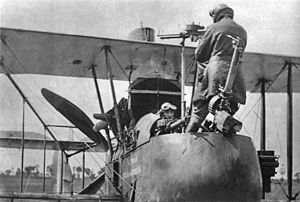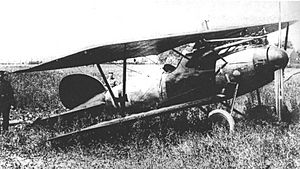Donald Cunnell facts for kids
Quick facts for kids
Donald Charles Cunnell
|
|
|---|---|
| Born | 19 October 1893 Norwich, Norfolk, England |
| Died | 12 July 1917 (aged 23) near Wervicq, Belgium |
| Buried |
Bailleul Communal Cemetery Extension North, Bailleul, France
|
| Allegiance | United Kingdom |
| Service/ |
British Army |
| Years of service | 1915–1917 |
| Unit | Hampshire Regiment No. 20 Squadron RFC |
| Battles/wars | First World War |
Donald Charles Cunnell (born October 19, 1893 – died July 12, 1917) was a brave British pilot during the First World War. He was known as a "flying ace," which means he shot down many enemy aircraft. Cunnell is famous for a special reason: he was involved in an air battle where he wounded the legendary German pilot, Manfred von Richthofen, also known as the Red Baron. Sadly, Cunnell was killed in action over Belgium a few days later.
Contents
Early Life and Training
Donald Cunnell was born in Norwich, England, on October 19, 1893. His father was Charles Donald Cunnell. Donald went to Gresham's School in Holt.
Before joining the military, he trained to become an architect. He also spent two years in the Norfolk Officer Training Corps. This group helped prepare young people for military service.
Military Adventures
Donald Cunnell began his military journey in September 1914. He joined as a private soldier and quickly moved up in rank to sergeant. On November 2, 1915, he became a second lieutenant in the Hampshire Regiment. He served on the Western Front, which was a major battlefield in France and Belgium.
Becoming a Pilot
On November 24, 1916, Donald joined the Royal Flying Corps. This was the air force branch of the British military at the time. He was appointed as a temporary flying officer, meaning he was now a pilot!
He was promoted to lieutenant on March 1, 1917. By May 14, 1917, Cunnell became a flight commander with the temporary rank of captain. This meant he was leading a group of planes.
Between May 2 and July 11, Cunnell achieved nine victories. He flew an FE2d plane with No. 20 Squadron. Five of his victories were planes he destroyed, and four were forced "out of control."
The Red Baron Encounter
One of Cunnell's most famous moments happened on July 6, 1917. He was flying with his observer, Second Lieutenant Albert Edward Woodbridge. They were part of a patrol of six British planes.
Suddenly, they were attacked by German Albatros D.V planes. One of these German planes was flown by the famous Manfred von Richthofen, known as the Red Baron. During the intense fight, Richthofen was hit in the head and forced to land his plane near Wervicq. Cunnell's crew was given credit for this important victory.
It's often said that this was the only time the Red Baron was shot down in an air battle. However, another pilot, Edwin Benbow, had a victory over him earlier. But Cunnell's attack was the only time the Red Baron was actually wounded in action.
Albert Woodbridge, Cunnell's observer, described the battle:
Cunnell flew the FE plane with amazing skill. He turned it from side to side, dodging dives from above. He barely missed head-on crashes. The sky was full of planes, and the noise of engines and machine guns was deafening. Cunnell and I shot at four German planes from very close. I saw my bullets hit them, and those four planes went down. Some were on fire, just smoke and flames. Two planes came straight at us, and the first one was Richthofen's. His plane was completely red, and he was an incredible pilot! I fired my front gun, and Cunnell fired his side gun. Cunnell kept our plane steady, and so did the pilot of the all-red plane. We approached each other very fast. I kept shooting at the front of his plane. Then the Albatros suddenly dipped its nose and went under us. Cunnell turned our plane. We saw the all-red plane spin out of control. It was turning over and over. His engine was still running, so I thought I had at least wounded him. His head was the only part not protected by his engine, so I thought that's where he was hit.
Later, doctors found that the bullet that hit Richthofen might have come from behind. Even though Cunnell and Woodbridge were credited with the victory, some people think the bullet might have come from another British plane. Other pilots like Raymond Collishaw or his wingmen were also in the fight.
A Hero's End
Just a few days later, on July 12, 1917, Donald Cunnell was killed. His plane was hit by German anti-aircraft fire near Wervicq, Belgium. His observer, Lt. A. G. Bill, was able to fly their damaged plane safely back to base.
Donald Cunnell was buried at the Bailleul Communal Cemetery Extension North. This cemetery is in Bailleul, France, very close to the Belgian border.
Aerial Victories
Here are the confirmed aerial victories for Donald Charles Cunnell:
| Date | Time | Aircraft | Enemy Plane | Location |
|---|---|---|---|---|
| May 2, 1917 | 11:15 | F.E.2d | Albatros D.III (Destroyed in flames) | Comines |
| May 26, 1917 | 10:35 | F.E.2d | Albatros D.III (Destroyed) | Comines–Quesnoy |
| May 31, 1917 | 19:20 | F.E.2d | Albatros D.III (Destroyed) | Comines |
| June 5, 1917 | 08:10 | F.E.2d | Albatros D.V (Destroyed in flames) | Coucou |
| July 6, 1917 | 10:30 | F.E.2d | Albatros D.V (Out of control) | Wervicq |
| July 6, 1917 | 10:30 | F.E.2d | Albatros D.V (Out of control) | Wervicq |
| July 6, 1917 | 10:30 | F.E.2d | Albatros D.V (Out of control) | Wervicq |
| July 6, 1917 | 10:30 | F.E.2d | Albatros D.V (Out of control) | Wervicq |
| July 11, 1917 | 14:00 | F.E.2d | Albatros D.V (Destroyed in flames) | Wervicq–Menin |



